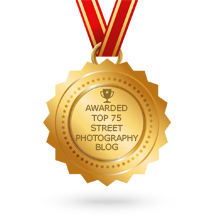In a recent blog, I mentioned about photographing with Kodak Portra 400 and I did my first roll, not on my rangefinder nor swing lens camera, but instead on a plastic toy camera, Vivitar PN2011. A compact point-and;-shoot camera with fixed focal length (aka focus free) of 28mm, wide angle plastic lens and fixed setting of aperture at f-stop 8.0 with fixed shutter speed of 1/125 second.
Make the jump to check out the color images.
I did post some black and white street photos I took with this toy camera here and I quite like the wide angle aspect and image quality. Though the images are not as sharp as those I shot with dSLR and rangefinder camera but the results are interesting. As I've mentioned in a previous blog, I think it's time to shoot color films again. So here are some of the street shots that I think are interesting.
The only good advantage I got from using this camera is that I can shoot a lot faster without having to spend quick seconds focussing and composing. It gives me more freedom to look out for my street subjects. It also trains my reflexes as well i.e. as and when things unfold right before my eyes, I need to anticipate and act fast to snap the shots. So during these split seconds moments, I'd just snap away without proper composing. It's similar to shooting from the waist kind of technique, aka lomography shooting dtyle. As the great master Henri Cartier-Bresson said that luck is one of the fsctors in doing street photography. Sufice to say, shooting from the hip, or pointing the camera at the subjects without looking through the viewfinder, might yield some disastrous results, if not for luck, one might get interesting lucky snapshots.
OK let's talk about Portra's color quality. Like most photographic images, post-process is always required to correct and enhance the overall color hue and saturation of the digitized images. To get good color results, good lighting condition is very important, with proper exposure settings. Based on my first roll, I can't say much unless I load a second roll on a film SLR or rsngefinder with good lenses and proper focussing, then we'll truly see how good Portra 400 colors are.
Using Vivitar PN2011 may yield soft and blur images but mostly it depends on the photographer's preferences and artistic visions. I'm still satisfied with my first Porta 400. Sure, every body likes to see clear sharp and colorful images. Personally, I think not every images, especially in street photography, have to be tact sharp. I'm more experimental and I like to try out new tools for different results and most importantly, to see what the streets look like when captured with the selected choice of films and cameras. Eventually, I'd stick to the ones that works well for me and use them long enough to fully understand their characteristic.
KODAK EKTAPRESS PJ100
I posted the Portra 400 image I took with my phone camera on my Facebook page and a kind friend of mine said that he would send me a couple rolls of Kodak Ektapress PJ100 color negative films for me to try on. How nice of him and I got them a few days ago in my mail box.
Currently one roll is loaded onto Vivitar PN2011 and I have since took 15 shots. It's Saturday today and a oublic holiday. I'll be hitting the streets later after posting this blog. Pretty excited every time I go out for street photography and I have so far accumulated about 10 rolls of undeveloped negatives, all Kodak Tri-X 400. I'm planning to shoot more first and then find time to develop all of them, 2 or 4 rolls at a time. Once all are done, scanning comes next. I'm so much looking forward to see those captured moments. Yeah I'll definitely post good street photos here from all those negatives including color ones from PJ100.
OK signing out now and preparing to hit the streets. So do subscribe to my blog to get updates and posts of my street photographs. You can visit my website here to see more street photos or other photographic work. Thank you for your time to read this blog.



























No comments:
Post a Comment